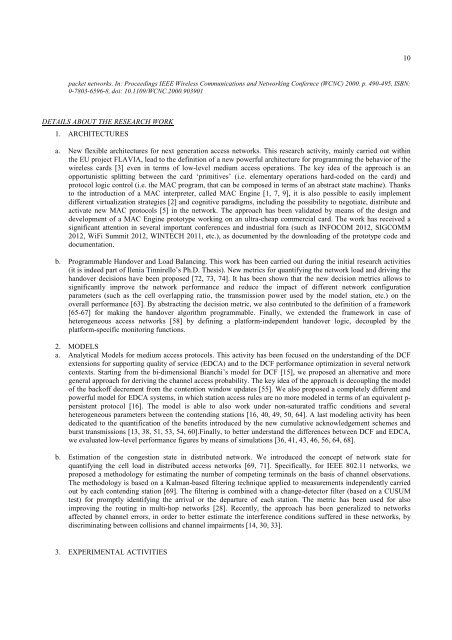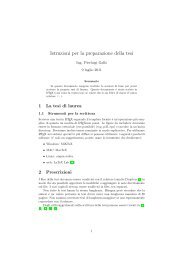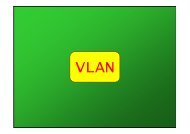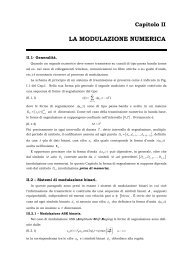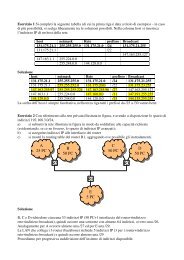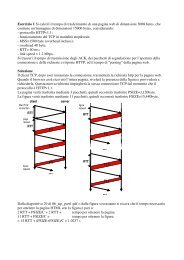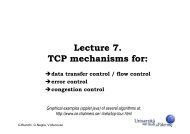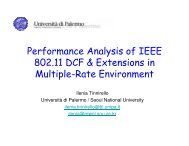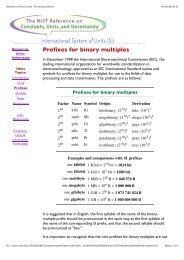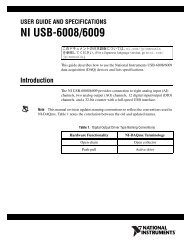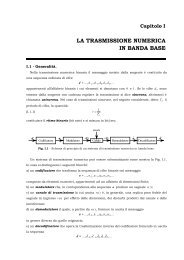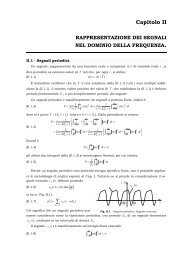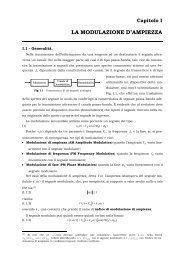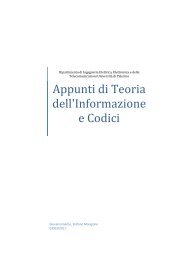Ilenia Tinnirello: Curriculum Vitae - Università di Palermo
Ilenia Tinnirello: Curriculum Vitae - Università di Palermo
Ilenia Tinnirello: Curriculum Vitae - Università di Palermo
You also want an ePaper? Increase the reach of your titles
YUMPU automatically turns print PDFs into web optimized ePapers that Google loves.
10<br />
packet networks. In: Procee<strong>di</strong>ngs IEEE Wireless Communications and Networking Confernce (WCNC) 2000. p. 490-495, ISBN:<br />
0-7803-6596-8, doi: 10.1109/WCNC.2000.903901<br />
DETAILS ABOUT THE RESEARCH WORK<br />
1. ARCHITECTURES<br />
a. New flexible architectures for next generation access networks. This research activity, mainly carried out within<br />
the EU project FLAVIA, lead to the definition of a new powerful architecture for programming the behavior of the<br />
wireless cards [3] even in terms of low-level me<strong>di</strong>um access operations. The key idea of the approach is an<br />
opportunistic splitting between the card ‘primitives’ (i.e. elementary operations hard-coded on the card) and<br />
protocol logic control (i.e. the MAC program, that can be composed in terms of an abstract state machine). Thanks<br />
to the introduction of a MAC interpreter, called MAC Engine [1, 7, 9], it is also possible to easily implement<br />
<strong>di</strong>fferent virtualization strategies [2] and cognitive para<strong>di</strong>gms, inclu<strong>di</strong>ng the possibility to negotiate, <strong>di</strong>stribute and<br />
activate new MAC protocols [5] in the network. The approach has been validated by means of the design and<br />
development of a MAC Engine prototype working on an ultra-cheap commercial card. The work has received a<br />
significant attention in several important conferences and industrial fora (such as INFOCOM 2012, SIGCOMM<br />
2012, WiFi Summit 2012, WINTECH 2011, etc.), as documented by the downloa<strong>di</strong>ng of the prototype code and<br />
documentation.<br />
b. Programmable Handover and Load Balancing. This work has been carried out during the initial research activities<br />
(it is indeed part of <strong>Ilenia</strong> <strong>Tinnirello</strong>’s Ph.D. Thesis). New metrics for quantifying the network load and driving the<br />
handover decisions have been proposed [72, 73, 74]. It has been shown that the new decision metrics allows to<br />
significantly improve the network performance and reduce the impact of <strong>di</strong>fferent network configuration<br />
parameters (such as the cell overlapping ratio, the transmission power used by the model station, etc.) on the<br />
overall performance [63]. By abstracting the decision metric, we also contributed to the definition of a framework<br />
[65-67] for making the handover algorithm programmable. Finally, we extended the framework in case of<br />
heterogeneous access networks [58] by defining a platform-independent handover logic, decoupled by the<br />
platform-specific monitoring functions.<br />
2. MODELS<br />
a. Analytical Models for me<strong>di</strong>um access protocols. This activity has been focused on the understan<strong>di</strong>ng of the DCF<br />
extensions for supporting quality of service (EDCA) and to the DCF performance optimization in several network<br />
contexts. Starting from the bi-<strong>di</strong>mensional Bianchi’s model for DCF [15], we proposed an alternative and more<br />
general approach for deriving the channel access probability. The key idea of the approach is decoupling the model<br />
of the backoff decrement from the contention window updates [55]. We also proposed a completely <strong>di</strong>fferent and<br />
powerful model for EDCA systems, in which station access rules are no more modeled in terms of an equivalent p-<br />
persistent protocol [16]. The model is able to also work under non-saturated traffic con<strong>di</strong>tions and several<br />
heterogeneous parameters between the conten<strong>di</strong>ng stations [16, 40, 49, 50, 64]. A last modeling activity has been<br />
de<strong>di</strong>cated to the quantification of the benefits introduced by the new cumulative acknowledgement schemes and<br />
burst transmissions [13, 38, 51, 53, 54, 60].Finally, to better understand the <strong>di</strong>fferences between DCF and EDCA,<br />
we evaluated low-level performance figures by means of simulations [36, 41, 43, 46, 56, 64, 68].<br />
b. Estimation of the congestion state in <strong>di</strong>stributed network. We introduced the concept of network state for<br />
quantifying the cell load in <strong>di</strong>stributed access networks [69, 71]. Specifically, for IEEE 802.11 networks, we<br />
proposed a methodology for estimating the number of competing terminals on the basis of channel observations.<br />
The methodology is based on a Kalman-based filtering technique applied to measurements independently carried<br />
out by each conten<strong>di</strong>ng station [69]. The filtering is combined with a change-detector filter (based on a CUSUM<br />
test) for promptly identifying the arrival or the departure of each station. The metric has been used for also<br />
improving the routing in multi-hop networks [28]. Recently, the approach has been generalized to networks<br />
affected by channel errors, in order to better estimate the interference con<strong>di</strong>tions suffered in these networks, by<br />
<strong>di</strong>scriminating between collisions and channel impairments [14, 30, 33].<br />
3. EXPERIMENTAL ACTIVITIES


